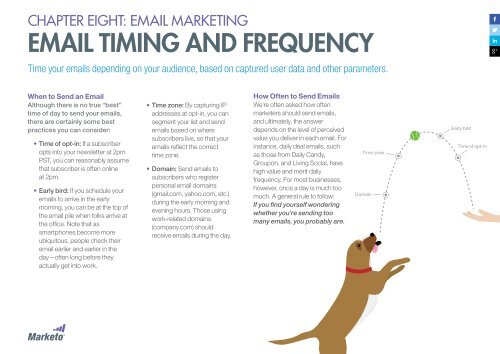The Definitive Guide to Lead Generation
TABLE OF CONTENTS Part One: Introduction to Lead Generation Chapter One: What is Lead Generation and Why is it Important? Chapter Two: How Has Lead Generation Evolved? Chapter Three: Defining a Lead Part Two: Lead Generation Tactics Chapter Four: Content Marketing and Blogging Chapter Five: Website and SEO Chapter Six: Landing Pages Chapter Seven: Social Media and Lead Generation Chapter Eight: Email Marketing Chapter Nine: Paid Programs Chapter Ten: Telephone-Based Lead Generation Chapter Eleven: Middle-of-Funnel Lead Generation Part Three: Optimize and Measure Your Lead Generation Chapter Twelve: Testing and Optimization Chapter Thirteen: Metrics Chapter Fourteen: Lead Generation Technology Conclusion: Lead the Way! Appendix: References
TABLE OF CONTENTS
Part One: Introduction to Lead Generation
Chapter One: What is Lead Generation and Why is it Important?
Chapter Two: How Has Lead Generation Evolved?
Chapter Three: Defining a Lead
Part Two: Lead Generation Tactics
Chapter Four: Content Marketing and Blogging
Chapter Five: Website and SEO
Chapter Six: Landing Pages
Chapter Seven: Social Media and Lead Generation
Chapter Eight: Email Marketing
Chapter Nine: Paid Programs
Chapter Ten: Telephone-Based Lead Generation
Chapter Eleven: Middle-of-Funnel Lead Generation
Part Three: Optimize and Measure Your Lead Generation
Chapter Twelve: Testing and Optimization
Chapter Thirteen: Metrics
Chapter Fourteen: Lead Generation Technology
Conclusion: Lead the Way!
Appendix: References
You also want an ePaper? Increase the reach of your titles
YUMPU automatically turns print PDFs into web optimized ePapers that Google loves.
CHAPTER EIGHT: EMAIL MARKETING<br />
EMAIL TIMING AND FREQUENCY<br />
Time your emails depending on your audience, based on captured user data and other parameters.<br />
When <strong>to</strong> Send an Email<br />
Although there is no true “best”<br />
time of day <strong>to</strong> send your emails,<br />
there are certainly some best<br />
practices you can consider:<br />
• Time of opt-in: If a subscriber<br />
opts in<strong>to</strong> your newsletter at 2pm<br />
PST, you can reasonably assume<br />
that subscriber is often online<br />
at 2pm.<br />
• Early bird: If you schedule your<br />
emails <strong>to</strong> arrive in the early<br />
morning, you can be at the <strong>to</strong>p of<br />
the email pile when folks arrive at<br />
the office. Note that as<br />
smartphones become more<br />
ubiqui<strong>to</strong>us, people check their<br />
email earlier and earlier in the<br />
day—often long before they<br />
actually get in<strong>to</strong> work.<br />
• Time zone: By capturing IP<br />
addresses at opt-in, you can<br />
segment your list and send<br />
emails based on where<br />
subscribers live, so that your<br />
emails reflect the correct<br />
time zone.<br />
• Domain: Send emails <strong>to</strong><br />
subscribers who register<br />
personal email domains<br />
(gmail.com, yahoo.com, etc.)<br />
during the early morning and<br />
evening hours. Those using<br />
work-related domains<br />
(company.com) should<br />
receive emails during the day.<br />
How Often <strong>to</strong> Send Emails<br />
We’re often asked how often<br />
marketers should send emails,<br />
and ultimately, the answer<br />
depends on the level of perceived<br />
value you deliver in each email. For<br />
instance, daily deal emails, such<br />
as those from Daily Candy,<br />
Groupon, and Living Social, have<br />
high value and merit daily<br />
frequency. For most businesses,<br />
however, once a day is much <strong>to</strong>o<br />
much. A general rule <strong>to</strong> follow:<br />
If you find yourself wondering<br />
whether you’re sending <strong>to</strong>o<br />
many emails, you probably are.<br />
Time zone<br />
Domain<br />
Early bird<br />
Time of opt-in

















